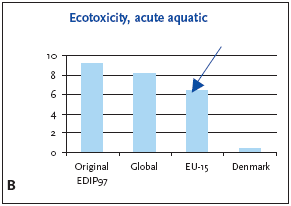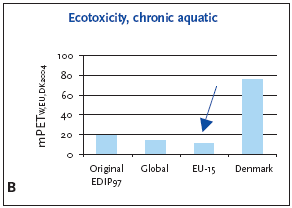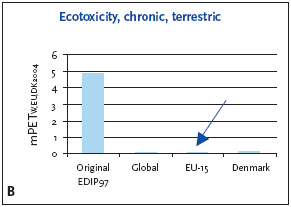|
Impact categories, normalisation and weighting in LCA 10. Ecotoxicity
Ecotoxicity - in an LCA context - covers a number of effects as acute and chronic toxicity on different species in soil and water. The fate of the chemical substances (biodegradability, potential bioaccumulation, biodegradability, and distribution between different compartments) is also included in the assessment of the ecotoxicological effects. The fate and effects are aggregated in a single parameter (toxic equivalence factors (EF)). The equivalence factors are determined for emissions to different compartments: air, water, and soil combined with acute and chronic aquatic effects and chronic terrestrial effects. 10.1 Substances contributing to the impact categoryThe substances contributing to ecotoxicity are numerous and cannot be described by even a finite number of groups. In the calculation of the normalisation reference for ecotoxicity, it has thus been the ambition to find the right order of magnitude. It is not possible to include contributions from all activities and the references are therefore expected to be on the low side; but they are believed to have the right order of magnitude. The normalisation references for ecotoxicity include impacts from:
10.2 Ecotoxicity potentialIn EDIP (Hauschild et al. 1998) the potential ecotoxic effects are expressed as critical volume, i.e. the volume of certain media required to absorb a specific emission without resulting in adverse effects. The ecotoxicity potentials are expressed by the following units, referring to the media in which natural organisms are exposed to the different substances:
When using this methodology ecotoxic potentials for all kind of substances can be aggregated to a single value for each effect, i.e. a critical volume. Ecotoxic equivalence factors (EF) for a number of substances as well as the methodology for calculating EF for other substances can be found in Hauschild et al. (1998). 10.3 Normalisation reference and weighting factor for ecotoxicityThe normalisation and weighting factors for ecotoxicity are calculated according to the general formula in chapter 1, Introduction; see Table 10.1 for presentation. Detailed information on the methodology and data sources used in the calculation of normalisation references and weighting factors can be found in Tørsløv (2005) and Busch (2005). Table 10.1 Normalisation references and weighting factors for ecotoxicity (acute aquatic, chronic aquatic and chronic terrestrial) (Tørsløv 2005; Busch 2005).
1 World-wide weighting factors have not been established; the European weighting factors are recommended for impact potentials located outside Europe or at an unknown locality. Ecotoxicity is considered as a local (especially acute ecotoxicity in water) and regional impact and the EU-15 normalisation references and weighting factor are recommended for impact potentials located in Denmark and Europe. If the location is unknown or outside Europe the global normalisation reference is recommended. 10.4 Example of applying normalisation reference and weighting for ecotoxicityFigure 10.1 - Figure 10.2 illustrate the normalised and weighted aquatic ecotoxicity potentials and Figure 10.3 illustrates the normalised and weighted terrestrial ecotoxicity potentials. For impact potentials located in Denmark the EU-15 normalisation reference combined with the EU-15 weighting factor for ecotoxicity are recommended. With the given impact potentials for the product in question, the resulting normalised and weighted values are: acute aquatic ecotoxicity chronic aquatic ecotoxicity chronic terrestrial ecotoxicity Figure 10.1 Normalised (A) and weighted (B) ecotoxicity potential, acute aquatic toxicity for production of a refrigerator at different localities.
Figure 10.2 Normalised (A) and weighted (B) ecotoxicity potential, chronic aquatic toxicity for production of a refrigerator at different localities.
The figures show that the chosen normalisation reference (EU-15) puts Figure 10.3 Normalised (A) and weighted (B) ecotoxicity potential, chronic terrestrial toxicity for production of a refrigerator at different localities.
more attention to acute aquatic toxicity, less to chronic aquatic toxicity and about the same to chronic terrestric ecotoxicity than the Danish normalisation reference. The global normalisation reference is in all three cases higher, but most noteworthy is perhaps the very heterogeneous picture that emerges when comparing the original EDIP values with those obtained by using the new normalisation and weighting factors. The differences may be caused by actual changes in the emissions that are used in calculation of the normalisation references, changes in the political targets in the affected areas, or they may be related to the extrapolation procedure applied in some of the calculations. It is outside the scope of this report to examine the differences in detail, but in practice it is therefore of interest to identify the most important contributions to these impact categories and find out whether there are improvement options that are related to specific concerns on the relevant markets. In other words, the example shows that a sensitivity analysis using different normalisation references can provide additional insight into the examined product system. 10.5 If you would like to know moreBusch, N.J. 2005, Calculation of weighting factors. In Stranddorf, H.K., Hoffmann, L. & Schmidt, A. Update on impact categories, normalisation and weighting in LCA. Environmental Project no. 995, Danish EPA, 2005. Hauschild, M., Wenzel, H., Damborg, A. & Tørsløv, J. 1998, Ecotoxicity as a criterion in the environmental assessment of products in Environmental assessment of products.Volume 2 Scientific background eds. Hauschild. M. & Wenzel. H. London: Chapman & Hall. Tørsløv, J. 2005. Ecotoxicity. In Stranddorf, H.K., Hoffmann, L. & Schmidt, A. Update on impact categories, normalisation and weighting in LCA. Environmental Project no. 995, Danish EPA, 2005.
|





